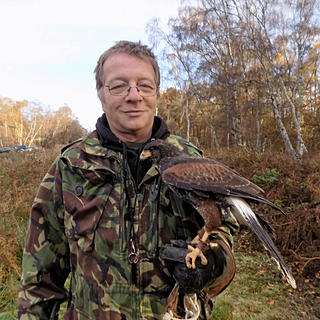The Harris hawk
- Rupert Gladstone
- Mar 1, 2018
- 3 min read

The Harris's hawk (Parabuteo unicinctus) formerly known as the bay-winged hawk or dusky hawk, is a medium-large bird of prey that breeds from the south-western United States south to Chile, central Argentina, and Brazil. Birds are sometimes reported at large in Western Europe, especially Britain, but it is a popular species in falconry and these records almost certainly all refer to escapes from captivity.
The name is derived from the Greek para, meaning beside, near or like, and the Latin buteo, referring to a kind of buzzard; uni meaning once; and cinctus meaning girdled, referring to the white band at the tip of the tail.
John James Audubon gave this bird its English name in honour of his ornithological companion, financial supporter, and friend Edward Harris.
The Harris's hawk is notable for its behaviour of hunting cooperatively in packs consisting of tolerant groups This lifestyle, unusual for raptors, has earned them the nickname "Wolves of the Sky.",
It is the Harris hawk's intelligence that leads to its social nature, which results in easier training and has meant that Harris hawks have become a popular bird for use in falconry.
Harris's hawks exhibit an unusual behavior called "stacking." A single Harris's hawk will perch on a cactus, and 2 to 3 additional birds will stand atop his back. With a shortage of tall trees in their habitat, this behavior helps them to better see prey and predators. Even a captive bred Harris Hawk shows this behaviour.
Harris hawks may perch in a low tree; dashing through thorny bushes in search of prey. Conversely, in the early morning, it may circle like a buzzard on thermals high above.
The above video shows Maya 4 month old Harris in the woods and also first Time out in the open soaring above a local BMX track. Have to put in a special thanks to Jack Little for allowing us to use his music for some of our videos.
Harris hawks prey on rabbits, small mammals, quail, other birds, reptiles and insects.This makes them ideal birds along with there ability to work as a team and the social nature ie the relationship the develope with there Falconer to be and Ideal Bird of Prey for Pigeon Rabbit control within the pest control Industry.
The following is based round Wild Harris Hawks
Females are polyandrous: they may have more than one mate. Often, birds form a trio with two males breeding with one female. The female and her mates all care for the young.
As with many raptors, aerial displays are an important part of Harris's hawk courtship. Males will dive vertically for several hundred feet, and then land near or on the back of the female.
Nests are built in cacti or trees, 8 to 30 feet above ground. Nests are made of sticks, twigs, mesquite and yucca.
The breeding season is long, from February to June; two or three broods can be hatched.
A clutch of two to four eggs are laid.
Incubation: 35 days. Both males and females incubate the eggs.
Other birds, from recently fledged juveniles to adults, often assist in raising the young.
Fledging: 40-45 days
The young remain the nest area two to three months after hatching.
Typical weights and measurements of wild Harris Hawks
Females: 1.4 to 2.6 pounds with a 40- to 48-inch wingspan Males: 1.4 to 2.0 pounds with a 38- to 45-inch wingspan Length: both sexes: 18 to 24 inches













Comments